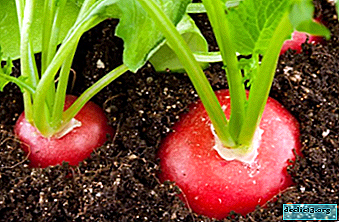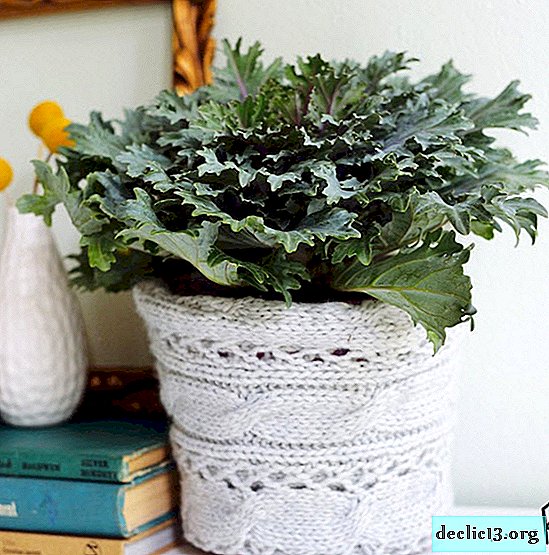The secrets of growing radishes. Variety selection and instructions for the cultivation and care of root crops
 Radish - a plant of the cabbage family - is the owner of a spicy taste, due to the high content of mustard oil.
Radish - a plant of the cabbage family - is the owner of a spicy taste, due to the high content of mustard oil.
Due to cold resistance, early maturity and undemanding care, it appears on our table in the spring, ahead of all other vegetables.
Creating optimal conditions will allow it to be cultivated year-round. Read more about this in this article.
Features and secrets of agricultural technology
- Radish is one of the most precocious crops. The early varieties mature in 18–20 days, and later in 35–40. Good cold resistance makes it possible to sow its seeds in open ground soon after the snow cover has melted. With proper care from one ridge in one vegetative season, you can harvest 3, and in the southern regions - 4 crops.
- In the period when the daylight hours exceed 13 hours, the radish begins to produce seed arrows, and the root crops that have begun to grow lose their edibility and become hollow. For this reason, vegetable growers prefer to grow this crop during short daylight hours - in the spring or fall months.
- High cold resistance allows to plant radish on ridges intended for heat-loving crops (eggplant, tomatoes, peppers). By the time it comes to sowing, the radish crop is ready.
- Early ripening radishes are often used as a lighthouse culture when planted together with other plants (tomatoes, parsley, carrots), the shoots of which appear much later. This helps to loosen the aisles and free them from weeds until the first seedlings appear.
- Unlike all other vegetables, radish is the owner of a shallow root system and therefore especially needs a sufficient amount of moisture. Its lack provokes elongation of root crops and a deterioration in their taste.
- Radishes are very dependent on light. In the shade, its tops are stretched, and the root crops are either not tied, or they turn out to be very small and hard.
- In autumn, radishes are grown as a second crop, fertilizing the soil with a mixture of mineral fertilizers (20 g of nitrogen, 30 g of superphosphate, 15 g of potassium salt).
- The best precursors for radishes are potatoes, onions or garlic. It is strictly forbidden to sow it after any plants of the cabbage family.
- Rows for winter sowing of this crop have been prepared since autumn: they are dug up to a depth of 30 cm, fertilized with compost, humus, superphosphate and potassium salt are added. Having made grooves, they cover the ridge with polyethylene until the first snow falls or until the soil freezes to a depth of 5 cm.
Variety selection for cultivation
The table will help determine the choice of variety:
| Grade name | The main advantages | Ripening period (in days) | Coloring, form, taste, weight of root crops | Features |
| 18 days | Shooting resistance | 18 | Red, cylindrical, slightly sharp, up to 25 g | It is unstable to frost, needs good lighting, when grown in the shade, it leaves in tops and knots small root crops |
| Duro Krasnodar | Friendly ripening of fruits, resistant to darting, sagging and cracking of root crops | 25 | Bright red, spherical, spicy-sweet, 30-40 g | |
| French breakfast | Resistance to cold and disease, high productivity, excellent presentation | 21-25 | Bright scarlet with a white tip, elongated-cylindrical, without bitterness, 15-40 g | |
| Wurzburg 59 | Color fastness | 25-35 | Red raspberry, round, sweet, 14-17 g | Recommended for outdoor use. |
| Alba | High productivity, disease resistance, not susceptible to shooting | 23-32 | White, oval, good, 23-25 g | Adapted to mid-latitude conditions |
| Autumn giant | Shelf life - 5 months. | 25-28 | White, rounded oval, slightly sharp, 120-170 g | Requires a lot of light |
| Red giant | Cold resistance, excellent productivity, good keeping quality, resistance to shooting | 40-50 | Dark pink with white furrows and a white tip, long-cylindrical, piquant, without bitterness, 50-150 g | Resistant to drought, unpretentious |
How to grow radish and properly care for it?
In this section of the article, you can familiarize yourself with different methods of growing radishes.
At home
 Radish houses are grown in:
Radish houses are grown in:
- deep pots;
- balcony drawers;
- plastic cassettes.
All containers should be equipped with drainage holes to prevent stagnation of moisture, as well as a drainage layer consisting of expanded clay or coarse pebbles. The ideal substrate for radish should be fertile, loose, with neutral acidity.
You can use the soil mixture, consisting of compost, peat and river sand, taken in a ratio of 2: 1: 1. Before sowing seeds, it is disinfected by roasting in the oven.
Sowing Instructions:
- Tanks are filled with soil, leaving a little space in case you need to pour earth into pots with elongated seedlings.
- The soil is abundantly moistened.
- Make grooves with a depth of 1.5 cm, spaced 10 cm apart.
- Every 5 cm spread the seeds.
- Crops are sprinkled with soil and moistened with a spray bottle.
- The container is covered with a piece of polyethylene and put in a dark place with an air temperature of 16 to 20 degrees.
- Under optimal conditions, seedlings will appear in 3-4 days.
- After that, the film is immediately removed, and the container with seedlings is moved to a glazed balcony.
Further care consists in regular watering, loosening the soil and maintaining the temperature regime:
- before fruiting, the air temperature during the day can be 20-22 degrees, at night drop to 5-6;
- during the formation of fruits, the temperature should not be higher than 18 degrees, at night - within 8-10 degrees.
We offer you to watch a video about the features of growing radishes on the windowsill at home:
In the greenhouse

- In unheated greenhouses, they begin to prepare the land for sowing radishes from the moment when it warms up to a depth of 5 cm. In the Non-Chernozem zone this happens in late March - early April.
- Before sowing seeds, the soil is fertilized with rotted compost (in a bucket for each sq. M) and a mixture of mineral fertilizers: potassium chloride and superphosphate (20 and 40 g per sq. M, respectively).
- Of great importance is the choice of the right variety. Since there is not so much light inside the greenhouse as outside, you should choose varieties for it that do not require bright lighting and which at the same time can bring an excellent harvest. The following grades correspond to these requirements:
- "Early red."
- Sachs.
- "Dawn."
- "The globe".
- Planting scheme: 2-3 cm between adjacent bushes, 7-8 cm between rows, seed placement depth - 1 cm. Seed consumption rate - 5 g per square meter. m
- Active seed germination in the greenhouse occurs when the soil temperature is at least 10 degrees.
- The optimal air temperature, contributing to the rapid growth of radishes, can vary between 15-20 degrees.
- If the lighting in the greenhouse is insufficient, you can resort to artificial illumination of crops.
- Watering should be regular and moderate, able to provide constant soil moisture to a depth of 7-8 cm. In order not to provoke the appearance of a black leg, the greenhouse should be periodically ventilated.
- To ensure a constant flow of fresh root crops to the table, radish should be sowed in the aisles. With a constant alternation of crops during the warm period, up to 15 crops can be harvested.
We offer you to watch a video about the features of sowing and growing radishes in a greenhouse:
Under the film
 Before you grow a radish under a film, you need to find out what this root crop likes. Since the radish sprouts at a temperature of +5 degrees, it is planted under the film in March.
Before you grow a radish under a film, you need to find out what this root crop likes. Since the radish sprouts at a temperature of +5 degrees, it is planted under the film in March.
During its first decade, the soil is freed from the remnants of the snow cover and covered with a black film, reliably fixing it with boards or stones.
After 2 weeks, the film is removed, the soil is raked and the radish is sown, according to the algorithm:
- Having made shallow (up to 2 cm) grooves spaced 10 cm apart, spill them with water.
- Seeds are laid out every 2-3 cm.
- Furrows are covered with loose sandy soil.
- Snow is thrown onto the sown bed, the gradual melting of which will saturate it with moisture.
- A shelter from arcs and a film is built over the garden, which is carefully fixed.
- The first shoots appear in 5 days.
Further care consists in performing standard agricultural practices:
- In order for root crops to develop actively, they need to ensure optimal soil moisture, preventing its stagnation and drying out. When setting hot weather, the beds are watered in the morning.
- After each irrigation, surface loosening of the soil is carried out: this will prevent the appearance of a hard crust, provoking cracking of radish. Loosening is combined with weeding and hilling of bushes to the level of cotyledon leaves.
- How to thin out thickened radish crops: after the first true leaf appears, remove excess plants, leaving a 5-centimeter interval between the bushes.
- If the radish is grown on lean soil, during the formation of root crops it is fed with a solution prepared from 1 tbsp. tablespoons nitrofoski and 10 liters of water (at the rate of 3 liters per 1 sq. m).
In the open ground in the country
The preparation of the site intended for the cultivation of radishes consists in digging it, introducing rotted manure (per bucket per 1 sq. M) and leveling the surface of the soil.

- The prepared ridge is well watered and rows are made with a depth of not more than 3 cm with an interval of 10-15 cm.
- Every 5 cm, seeds are placed individually.
- Having fallen asleep, they gently slap them with the palm of their hand, achieving better soil contact with the seeds: this will accelerate their germination. In good weather, this happens for 3-4 days. Under adverse weather conditions, sprouts of radishes appear in 6-12 days - this is how much the root crop grows in open ground.
- To get juicy root vegetables, radishes planted in April are recommended to cover with a spanbond for the night.
Rules for competent care of radish in the country in the open ground:
- Freshly sown radishes are watered daily.
- Weeding and loosening of the soil should be regular.
- Drying of the soil can be avoided with the help of a 2-centimeter layer of mulch (peat or humus is suitable as such).
- In order to achieve optimal (up to 80%) soil moisture, radish should be watered frequently.
- Some doubt whether it is necessary to thin out the thick shoots of radishes. In fact, this is necessary, and the optimal interval between plants is 5 cm.
We offer you to watch a video about the features of growing radishes in open ground:
How to get a good and large crop?
There are many methods for growing radishes, allowing you to get a good harvest.
In cassettes
Using egg cartridges allows you to:
- sow seeds at an optimum distance for them;
- protect plants from weeds;
- hold moisture in the soil for a long time.
The technology for cultivating radishes in cassettes is very simple:
- Cassettes intended for sowing are disinfected either by wiping them with alcohol or by heating (at 70 degrees) for an hour in the oven.
- The bottom of the cells is cut with the help of an office knife.
- Cassettes are placed on a prepared bed (with cut bottoms down) and lightly pressed into the soil.
- With the help of wire staples, the containers are fastened to the bed so that they are not carried away by a gust of wind.
- Putting one seed in each cell, sprinkle them with peat.
We offer you to watch a video about the features of growing radishes in cassettes:
On hydroponic installations
 Hydroponics, which provides good nutrition of the root system, eliminates the need for transplants and frequent feedings, negatively affecting the development of radishes.
Hydroponics, which provides good nutrition of the root system, eliminates the need for transplants and frequent feedings, negatively affecting the development of radishes.
To grow radishes in hydroponics, you must:
- Choose the right variety. Suitable varieties are those characterized by early maturity, good yield, resistance to shooting and not requiring bright lighting. The varieties "Carmen", "Sora", "Famox", "White Fang", "Celeste" and others meet these requirements.
- Prepare a special nutrient solution, each liter of which contains: 45 mg of magnesium, 280 mg of potassium, 80 mg of calcium, 140 mg of sodium, 40 mg of phosphorus. As a solvent for the above substances, water is used.
- Stock up on plastic cassettes (the optimal cell size is 5x5x5) and pallets, through which the roots will be fed with a nutrient solution.
- Fill the cells with tomato soil or a mixture containing perlite and peat (in a ratio of 2 to 8).
Step-by-step landing instructions:
- The soil in the cassettes is moistened.
- One seed is placed in each cell to a depth of 1.5 cm.
- Crops are sprinkled with sifted peat and sprayed from a spray bottle (water should be warm).
- The cells are covered with polyethylene and wait for the emergence of seedlings.
- After sizing seeds, the film is removed. When two sprouts are found in one cell, one of them is not torn out, but pinched to avoid damage to the roots of the remaining seedling.
Care:
- After emergence in the daytime, the cartridges are kept at a temperature of 10 degrees, at night - at 8. During the germination of the first true leaf, the night temperature remains the same, and the day temperature rises to 16 degrees. During the formation of root crops, the temperature should be at the level of 18-20 degrees.
- Before the first leaflet appears, the crops are moistened with water using a spray gun. Next, for irrigation use a hydroponic nutrient composition, pouring it into the pan. It is necessary to ensure that the soil moisture is kept at 70%.
- If you are interested in how to grow a crop quickly, it should be noted that for the ripening of root crops the radish needs 12-hour lighting with a power of 9 to 14,000 lux. With a longer daylight, the plants begin to shoot. If the radish is grown in short daylight conditions, it is provided with additional illumination using phytolamps.
Problems

- Root cracking may result from either uneven irrigation or an excess of moisture in the soil. To solve this problem, it is necessary to maintain optimal soil moisture, preventing neither its drying out nor excessive moisture.
- Radish shootingwhich leaves in color and gives very small, hard and bitter root crops, can be caused by: frost, prolonged dry soil, hot weather, thickened plantings, the presence of a long (more than 12 hours) daylight. To avoid this problem, you should:
- use the seeds of varieties resistant to flowering;
- plant radish on a site with moisture-resistant, loose soil with neutral acidity;
- to plant seeds to a depth of not more than 2 cm;
- prevent thickening of landings;
- provide regular moderate watering;
- To mulch the beds, use humus or dry peat.
- Stretching plantswho do not want to tie root crops or produce too small fruits, may be due to: shaded area, thickened planting or deficiency of potash fertilizers. To correct the situation, you can:
- pruning plants that shade the garden;
- fertilize using phosphorus or potassium fertilizer;
- thin out seedlings, leaving 4-5 cm between adjacent bushes.
Harvesting and storage
- Harvesting radishes ripening at different times is carried out selectively, preferably in the morning, not forgetting to water the garden plentifully in the evening.
- The dug root crops are shaken, freeing them from the remnants of the earth.
- Having retreated 20 mm from the fetus, cut the tops (roots must be left).
- Root crops are washed and dried a little, eliminating drops of moisture.
- The collected radishes are placed in a plastic bag and stored for a week in the refrigerator, in the vegetable compartment.
Disease
Planting radishes, which have a short growing season, can sometimes suffer from:

- Kiel - fungal infection, provoking the appearance on the fruits and roots of radish spindle-shaped and spherical growths and seals. As the disease develops, the roots become brown and begin to rot. At the same time, the tops turn yellow and fade. If affected root crops are found, the soil on the bed is treated with a solution prepared from 10 liters of water and 2 glasses of fluff-lime (at the rate of 1 liter of milk of lime per 1 bush).
- Vascular bacteriosis - a disease in which moist dark spots appear on the outer and inner sides of young leaves, and old leaves acquire a purple fringing and, having crumbled, fall off. You can cope with the disease by spraying the tops with Bordeaux liquid (1% solution). Good results are obtained by spraying plants with a solution of the biological product "Albit", prepared in strict accordance with the manufacturer's instructions.
- Black legs - a fungal infection affecting the stems of newly ascended seedlings. To combat the disease, the seedlings are sprayed with a solution (1%) of copper sulfate with the addition of laundry soap or infusion of onion husks (20 g per 1000 ml of water).
- Scab - a disease in which large black holes with uneven edges form in root crops. The scab can be prevented by carefully observing crop rotation, timely weeding of weeds and acidification of the soil.
Pests
Radish plantings may be attacked:
- wireworm;
- beetle of a babanuha;
- cabbage white caterpillars;
- nematodes;
- rapeseed sawfly;
- cabbage flies;
- crucifer bug.
The cruciferous flea is capable of causing the greatest damage to this culture (especially young shoots).
 To combat it, they resort to:
To combat it, they resort to:
- Spraying the tops with a solution, which includes: laundry soap (40 g), wood ash (2 cups) and water (10 l). Processing is performed weekly.
- Dusting leaves with tobacco dust.
- Watering the beds with a solution of citric acid (1 tbsp.spoon in a bucket of water).
- Processing plantings with a solution of Inta-Vir or Karate.
We suggest watching a video about radish pests and methods of controlling them:
Shooting Prevention
In order to avoid shooting radishes in hot weather and long daylight hours, gardeners resort to artificially shortening it using the following technique:
- A frame is made whose dimensions coincide with the length and width of the beds, and the height does not exceed 30 cm.
- Any light-tight material is used to tighten the frame.
- At 19-00, the frame is installed on the bed, and at 7-00 it is removed.
Growing radishes is not associated with large labor costs. Having created optimal conditions for it and performing simple agricultural techniques, it is possible to ensure the continuous supply of root crops to your table for a whole year.

















